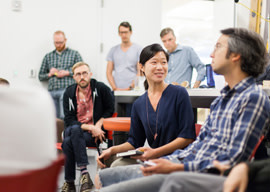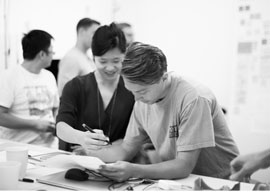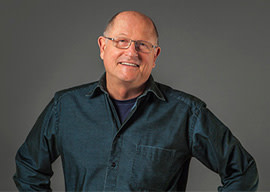
We’ve seen how agile design and development can enable you to understand customers, create and iterate meaningful solutions, and quickly bring a full-scale offering to market. Your organization’s success in adopting and reaping the benefits of agile design and development depends on your team’s understanding of their roles, their interactions with their teammates, and their conception of the overall process and its goals. If handled improperly, agile design and development can introduce challenges related to different working styles, priorities, and communications. Properly positioning your team is critical for success.
The people involved and the roles they play will shift across the three phases. One constant through this process, however, is a consistent leader who can guide and oversee the original business challenge, the design of the solution, and product creation and evolution. Depending on your organization’s structure, this role may be called Product Owner, Product Director, or Product Manager, and depending on your organization’s size and hierarchy, may be split amongst multiple people. Regardless, it’s important that at least one person be leading this agile design and development process throughout so the intent of the design has a consistent and informed champion at every phase. In this post, we’ll call that person the Product Manager.
Your organization’s success in adopting and reaping the benefits of agile design and development depends on your team.
Phase One: Envision and Resonance Test
In this phase, the Product Manager should first form a clear, concise definition of the problem to be solved—a challenge statement. They should consult all necessary stakeholders in the organization to ensure that the challenge statement will direct the work appropriately and will likely lead to a satisfying outcome for the organization. As people join the effort, the challenge statement will help everyone stay focused in the same direction.
With problem statement in hand, the Product Manager should form a team of experts in research, analysis, and ideation, which could include customer experience experts, ethnographic researchers, quantitative researchers, and design strategists. This team will first seek to understand users and their needs through an appropriate mix of in-context interviews, surveys, and other data.
Then they need to process this research to form insights and opportunity areas that can prompt and evaluate ideas. Insights are short statements that describe an important customer truth or challenge. For example, insights can take this form: “Users want to [something they’re trying to accomplish], but [something that’s holding them back].” Opportunity areas are statements of addressable need in the market; they describe big user problems the team can solve. Together, insights and opportunity areas help the team verify that the ideas they create are solving real needs and right for users.
As people join the effort, the challenge statement will help everyone stay focused in the same direction.
The team should then generate ideas and evaluate and prioritize them, guided by insights and opportunity areas. The Product Manager might invite others in the organization, including project sponsors and managers in related business units, to join in. The team then needs to envision the experience created by the selected idea, or ideas, in a way that communicates their intent to future team members, other relevant people in the organization, and potential users.
This phase concludes with a Resonance Test. The team should test the envisioned concepts with users to understand how and to what degree the proposed solutions are relevant to them, meet their needs, and deliver things they value. The key to a good Resonance Test, and successful iteration afterward, is understanding why people reacted the way they did to envisioned concepts, not just whether or not they liked them. After the test, the team may need to tweak details, edit ideas, or pivot to a different solution entirely based on user feedback. If necessary, the team may need to grow to include designers who can create mock-ups, testing materials, protocols, and run tests with users.
Phase Two: Prototype and Resonance Test
The ideal output is a passable, functional front end with a back end comprised of spreadsheets and human labor instead of custom databases and complex algorithms.
At this point, the Product Manager should have a clear sense of the intent of the product the team will develop, as well as a high-level idea of its shape and the major functions it will perform. For this phase, design strategists, designers, and testers should still be involved, and the team should include developers who can start to build the experience with real code. However, it’s important that these developers can work in a duct-tape-and-baling-wire mindset; they won’t yet be building at full scale.
This phase requires especially careful management, expectation setting, and team selection. The group needs to build an experience to serve two primary purposes, which can seem at odds with one another if not properly framed. The team is working with a foundation of real code, which will surely surface technical challenges, and laying the groundwork for the full-scale product. Simultaneously, they are testing the experience to refine it and define the details, which invites them to redesign or create new capabilities and features based on user feedback.
The designers and developers must now work closely together and make difficult choices about how much of the experience should be built with code and how much can be simulated for the purpose of testing and learning. They must be comfortable with failure and iteration, as part of the process of developing a meaningful and valuable product.
The ideal output is a passable, functional front end with a back end comprised of spreadsheets and human labor instead of custom databases and complex algorithms. The team should engage in one or more rounds of Resonance Testing with users, presenting the experience to them and evaluating the results.
Phase Three: Pilot and Usability Test
As the Product Manager sets up the team and develops an agile design and development process, it’s important to provide regular check-ins, coaching, and guidance for leaders and team members.
Phase Three will likely be most familiar to your agile development organization, as it’s focused on releasing a product into the market. At this point, the strategic perspective should still be represented to preserve the design intent, but the balance of the work will shift to developers.
The team will launch its pilot to demonstrate and measure its value to users and collect real-world usage data and feedback to help them improve the product and shape future development. Developers and testers are key here, as surfacing user reactions in usability testing will help ensure that the product grows continually more relevant and useful to its target audience.
Making the Dream Work
As the Product Manager sets up the team and develops an agile design and development process, it’s important to provide regular check-ins, coaching, and guidance for leaders and team members. It’s critical to identify points of confusion or failure before they become systemic.
Follow the advice above, and your organization should be able to build a strong, flexible team. And once that group is up and running—if not sprinting—you’ll see a marked improvement in the ability to bring relevant, high-value, continually improving products to market.





